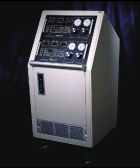The Thoratec Ventricular Assist Device (VAD) can be used to support patients with acute and chronic heart failure. Doctors have gained approximately 20 years of experience with this system at numerous medical centers around the world. The Texas Heart Institute began using the Thoratec VAD in 1997.
 The Pump
The Pump
One or two Thoratec VADs can be used to provide left, right, or biventricular support. The blood pump is positioned outside the body (extracorporeally) and connected to tubes (cannulas) inserted into the heart. The pump has a rigid plastic case that contains a flexible pumping sac. Blood is ejected from the pump when the pumping sac is compressed by air from the external control console. Within the inflow and outflow conduits, mechanical valves control the direction of blood flow. The Thoratec VAD has a stroke volume of 65 milliliters. It can be operated at up to 100 beats per minute, resulting in blood flow rates of up to 7 liters per minute.
The Console
 The Thoratec console has control modules and internal compressors that provide pressure and vacuum conditions to the pump. The drive console delivers air to the blood pump in a pulse-like fashion, causing blood to be ejected into the aorta and/or pulmonary artery. The drive console may be set to 3 different modes of operation: asynchronous mode (pumping occurs at a preset rate), synchronous mode (pumping is synchronized with the patient's heart rate), or volume mode (pumping is adjusted according to the left ventricular filling volume). The console continuously displays the ejection pressure, percent ejection time, pump rate, pump flow, and vacuum pressure. Because of the external placement of the pump(s), patient mobility is limited with this system.
The Thoratec console has control modules and internal compressors that provide pressure and vacuum conditions to the pump. The drive console delivers air to the blood pump in a pulse-like fashion, causing blood to be ejected into the aorta and/or pulmonary artery. The drive console may be set to 3 different modes of operation: asynchronous mode (pumping occurs at a preset rate), synchronous mode (pumping is synchronized with the patient's heart rate), or volume mode (pumping is adjusted according to the left ventricular filling volume). The console continuously displays the ejection pressure, percent ejection time, pump rate, pump flow, and vacuum pressure. Because of the external placement of the pump(s), patient mobility is limited with this system.
For more information, you can read an article entitled, "Univentricular and Biventricular Thoratec VAD Support as a Bridge to Transplantation," which appears in Volume 55 (1993) of the journal Annals of Thoracic Surgery (pp. 276-282).



